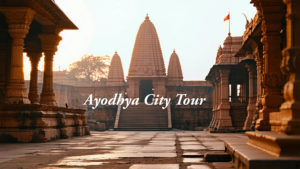Surya Kund, Ayodhya – The Sun-Pond of Sacred Solace

If you are building your list of Ayodhya sightseeing places, one of the tranquiler gems you should not miss is Surya Kund. Among the many Ayodhya tourist spots, places to see like Ram Janmabhoomi and Hanuman Garhi, Surya Kund offers peace, ritual purity, and a connection with Ayodhya’s ancient spiritual fabric. Whether you are a pilgrim, a heritage-lover, or just looking for quiet spots, Surya Kund is a place to visit in Ayodhya that balances devotion, culture, and calm.
Where Is Surya Kund?
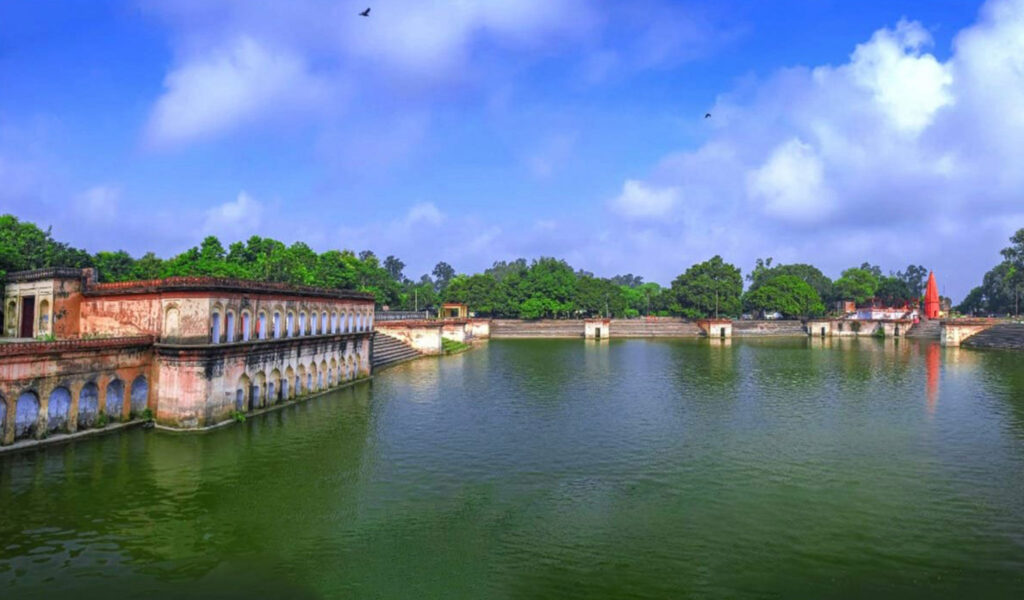
Surya Kund, also known as Suraj Kund, is a sacred water reservoir located just 4 km from the heart of Ayodhya, Uttar Pradesh, making it one of the most easily accessible Ayodhya sightseeing places. Situated along the traditional Panchkoshi Parikrama Path, often taken by pilgrims, the kund lies close to the route returning from Nandigram (Bharat Kund). Its surroundings are dotted with temples, shrines, and ghats (stone steps) where devotees perform rituals, bathe, and rest during the parikrama. Unlike the busier temple areas of the city, Surya Kund offers a more peaceful setting, enhanced by recent restoration work with Surya Stambhas (pillars), landscaped walkways, and lighting—making it not only a revered site for worship of the Sun God but also a serene tourist spot in Ayodhya for reflection and heritage exploration.
GPS Coordinates of Surya Kund
•Latitude: 26.7870° N
•Longitude: 82.1940° E
Mythological & Historical Significance of Surya Kund

1.Sun God Worship & Ikshvaku Dynasty
Surya Kund, sometimes referred to as Goshark Kunda, is deeply associated with the worship of Suryadeva (the Sun God). The Ikshvaku dynasty, to which Lord Rama belonged, considered the Sun their celestial patron. Rituals honoring the Sun were believed to bring prosperity, health, and divine blessings, making this kund an important site for their spiritual practices.
2.Legend of Lakshmana and Sita
According to local legends, Lakshmana created or preserved Surya Kund to provide cool, sacred waters for Goddess Sita during Lord Rama’s exile. This connects the kund not just with Sun worship but also with the Ramayana’s narrative of devotion and care within the family.
3.Healing Waters & Ritual Bathing
Devotees believe that the waters of Surya Kund have purifying and healing properties, especially beneficial for skin ailments. Ritual bathing here is considered highly meritorious, cleansing both body and soul. Pilgrims often visit the kund to take a dip during festivals or personal religious observances.
4.Architectural & Cultural Restoration
Once neglected, Surya Kund has recently undergone significant restoration by the government. Renovated ghats, decorative Surya Stambhas (sun pillars), landscaped walkways, and lighting now enhance the site. These developments have not only preserved its sanctity but also made it more appealing as a tourist spot in Ayodhya, blending heritage with visitor-friendly facilities.
What You’ll See & Do at Surya Kund
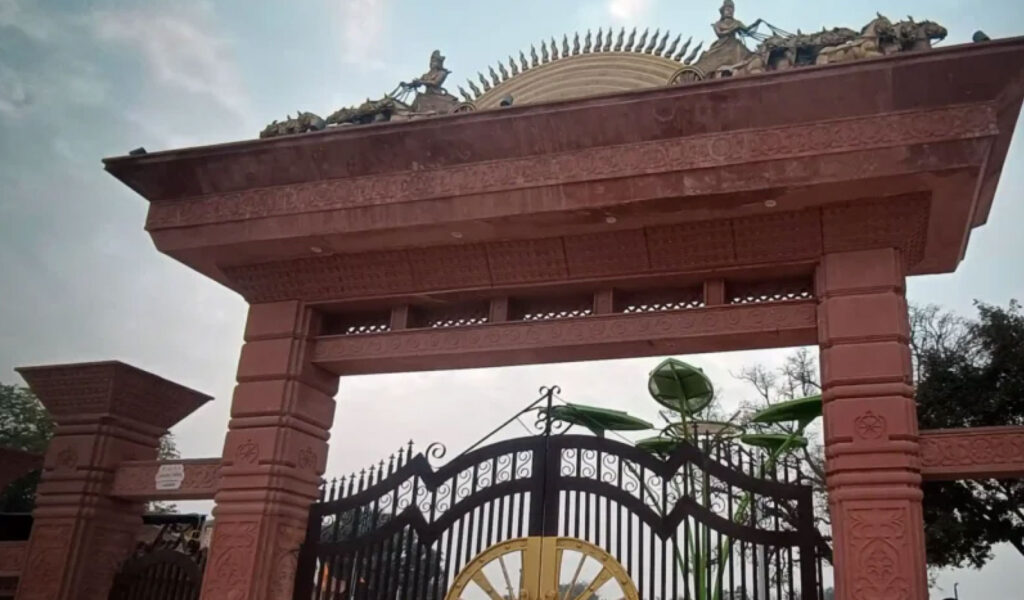
When you visit Surya Kund as part of your Ayodhya itinerary, you can expect a mix of ritual, culture, and natural calm. Here’s what to look out for:
1.The Kund (Water Reservoir / Tank)
A rectangular (or large square) pond with ghats or steps descending into the water. Many visitors come to perform puja or take a dip. The reflective water, especially in early morning or evening light, is quite soothing.
2.Ghats & Steps
Stone or brick ghats allow visitors access to the water. These are also used during festivals and rituals when many devotees gather.
3.Temples & Shrines
There is a small temple dedicated to Surya (Sun god) on the banks of the kund. Other nearby shrines and temples are also part of the spiritual ambience.
4.Cultural Events & Festivals
Surya Kund hosts religious processions, cultural fairs, and events. It is an active place during festivals related to Surya (Sun), as well as during Ayodhya’s many temple festivals.
5.Restoration & Artistic Elements
Recent restorations have added decorative Surya Stambhas (pillars), landscaped pathways, lighting, and even open areas for gathering. These enhancements make it not just spiritually important but also aesthetically pleasing, particularly at sunrise or sunset.
6.Peace & Natural Surroundings
The area around Surya Kund is quieter than some of Ayodhya’s busier temple zones. The waters, birds, gentle breeze, and open sky provide a place for meditation, reflection, or just a break from crowds.
Best Time to Visit & Tips
To make the most of your visit to Surya Kund:
•Time of day: Early morning or late afternoon offers cooler temperatures, softer light, fewer crowds.
•Season: Post-monsoon to early spring (October to March) is ideal; summers can be hot.
•Rituals: If you want to see or participate in rituals, check local temple schedules or festival calendars related to Sun worship.
•What to carry: Modest clothing (as with most religious sites), water, sun protection, comfortable footwear.
•Photography: Bring a good camera; light at sunrise/sunset is very beautiful. Respect rituals and people.
Why Surya Kund Should Be On Your Ayodhya Travel List
Here are a few reasons why Surya Kund makes for one of the must-see Ayodhya tourist attractions:
•It complements the big pilgrimage sites by offering calm and introspection.
•It has mythological depth (Sun God, Lakshmana, etc.) which enriches a heritage trip.
•It’s easily accessible and gives a different angle on Ayodhya’s religious geography.
•It has been enhanced/renovated, making the experience better for tourists without being overly commercial.
How to Reach Surya Kund (Suraj Kund)
• By Road: Surya Kund is only about 4–5 km from central Ayodhya / Ram Janmabhoomi Temple, so it’s very easy to reach by auto-rickshaw, e-rickshaw, or taxi. The ride takes just 10–15 minutes.
•By Rail: The nearest station is Ayodhya Junction (AY), from where Surya Kund is around 5 km away. You can hire local transport directly outside the station.
•By Air: The newly opened Maharishi Valmiki International Airport, Ayodhya is around 12–15 km away. From the airport, you can take a cab to Surya Kund. Lucknow’s Chaudhary Charan Singh Airport (≈135 km) is another option if you are flying into the region.
Nearby Places to Visit Along with Surya Kund
When you include Surya Kund in your Ayodhya sightseeing places, you can also cover these nearby attractions:
•Nandigram (Bharat Kund) – About 15–20 km away, where Bharat ruled during Rama’s exile.
•Dasharath Mahal – A royal palace associated with Lord Rama’s father, located in Ayodhya city (~4 km).
•Kanak Bhawan – A temple dedicated to Rama and Sita, famous for its golden idols (~4 km).
•Hanuman Garhi – A hilltop Hanuman temple with panoramic views (~5 km).
•Ram Janmabhoomi Temple – The birthplace of Lord Rama and Ayodhya’s most iconic pilgrimage site (~4 km).
•Ram Ki Paidi (Saryu Ghats) – For evening aarti, rituals, and riverfront peace (~4–5 km).
•Treta Ke Thakur Temple – An ancient temple with Rama’s footprints, open on special days (~5 km).
Since Surya Kund is so close to Ayodhya city, it can be comfortably combined with other Ayodhya tourist attractions in a half-day or full-day trip.
Suggested Itinerary: Ayodhya with Surya Kund
Morning
•Begin your journey at Ram Janmabhoomi, the birthplace of Lord Rama.
•Walk to Kanak Bhawan, famous for its golden idols of Rama and Sita.
•Climb up to Hanuman Garhi, a hilltop temple offering panoramic views of Ayodhya.
Late Morning
•Head towards Surya Kund (Suraj Kund), located about 4 km from the city centre.
•Spend time at the sacred pond, observe rituals, and visit the small Sun temple nearby.
•If interested, take a holy dip or simply sit by the ghats for peace and reflection.
Afternoon
•Return to the city for lunch at a local eatery.
•After lunch, explore Dasharath Mahal and Treta ke Thakur Temple, both linked with Lord Rama’s story.
Evening
•Visit the Saryu River Ghats (Ram Ki Paidi) for a serene riverside experience.
•End your day by witnessing the evening aarti at the Saryu Ghats, a breathtaking sight with chants, lamps, and devotion filling the air.
This itinerary lets you experience both the popular Ayodhya tourist attractions and the quieter charm of Surya Kund, making your trip spiritually fulfilling and culturally rich.
Frequently Asked Questions (FAQ) about Surya Kund, Ayodhya
1. What is Surya Kund / Suraj Kund?
Surya Kund is a sacred reservoir in Ayodhya, also known as Goshark Kunda or Prachin Surya Kund. It is dedicated to the Sun God (Suryadeva) and is part of the spiritual landscape of Ayodhya.
2.Where is Surya Kund located?
It is in the Darshan Nagar / Harlalka Road area of Ayodhya, Uttar Pradesh. It lies near the pilgrimage paths such as the Panchkoshi Parikrama. It is easily accessible from the city centre.
3.How far is Surya Kund from Ram Mandir / city centre?
About 4-6 km from the Ram Mandir or central Ayodhya area, depending on route. Distances vary among sources.
4.What is the mythological / historical significance of Surya Kund?
•It is associated with the Ikshvaku dynasty who worshipped the Sun.
•Legends claim that the Kund was created or preserved by Lakshmana to provide sacred water for Sita during exile.
•The pond is believed to have healing properties.
•There are temples and Surya Stambhas (pillars) around it.
5.Is there an entry fee for Surya Kund?
According to multiple travel guides, entry is free for visitors.
6.What are the opening hours / best times to visit?
•It is generally open early morning till midday, re-opening later in the afternoon/evening.
•Best time of year to visit is October to March, when weather is pleasant.
7.What are the important rituals or things to do at Surya Kund?
•Devotees take holy dips in the Kund.
•Offerings / prayers at the small Surya temple by the bank.
•Observing festivals such as Makar Sankranti which draw many devotees.
•Evening laser-show in some tour packages near Surya Kund.
8.Are photography and mobile/video allowed?
Yes, photography is allowed in and around Surya Kund for most public/religious areas. Respect religious rituals and restrictions may apply in some temple interiors.
9.What amenities are available near Surya Kund?
Basic amenities: ghats / steps, small temple complex, landscaped paths, lighting, seating. Some recent restoration and beautification works (pillars, gardens) have improved visitor experience.
10.What is the best time of day to visit Surya Kund?
Early morning or late afternoon/evening are best—cooler temperature, softer light, fewer crowds, good for rituals and photography. Also for special events (aarti/laser show).
11.Which is the nearest airport / how to reach from major cities?
•Ayodhya / Faizabad has local airport options; Lucknow airport (Chaudhary Charan Singh) is a common hub.
•From city centre, one can reach by local transport (auto/taxi) easily. Roads are improving due to restoration / pilgrimage infrastructure.
12.How much time should one allot for visiting Surya Kund?
Around 1-2 hours is sufficient to explore the kund, do rituals, walk around, take photos. If combining with other nearby sites, you might want more.
13.During which festivals is Surya Kund crowded / special events?
•Makar Sankranti is a big one when many devotees visit.
•Possibly during other Sun-worship related festivals. Some sites mention laser shows/festive evening events.
14.Is Surya Kund part of pilgrimage circuits / parikrama in Ayodhya?
Yes, it lies along or near the Panchkoshi Parikrama path and is among the spots pilgrims include when doing religious circuits of Ayodhya.
15.Is Surya Kund safe for bathing / dipping?
Tradition accepts ritual dipping. However, visitors should exercise caution with water depth, hygiene, and safety, especially for children / non-swimmers. (No specific official guidance seen in sources; common sense applies.)
Conclusion
Surya Kund is one of those Ayodhya places to see that sits quietly among the big temples but offers a unique spiritual refresh. For anyone seeking more than the headline attractions, looking to soak in Ayodhya’s devotional calm, or explore a tourist spot in Ayodhya that blends myth, nature, and ceremony, Surya Kund should be high on your list.
Plan your trip, include Surya Kund (along with the more famous spots), and you’ll leave Ayodhya with a fuller, richer experience of its sacred landscape.
Recommended Tour
Related Blogs
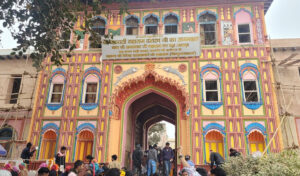
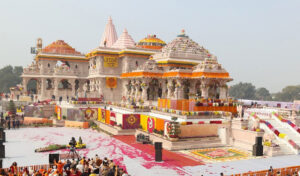
Sri Ram Janmbhoomi, Ayodhya – Where Divinity & History Meet


